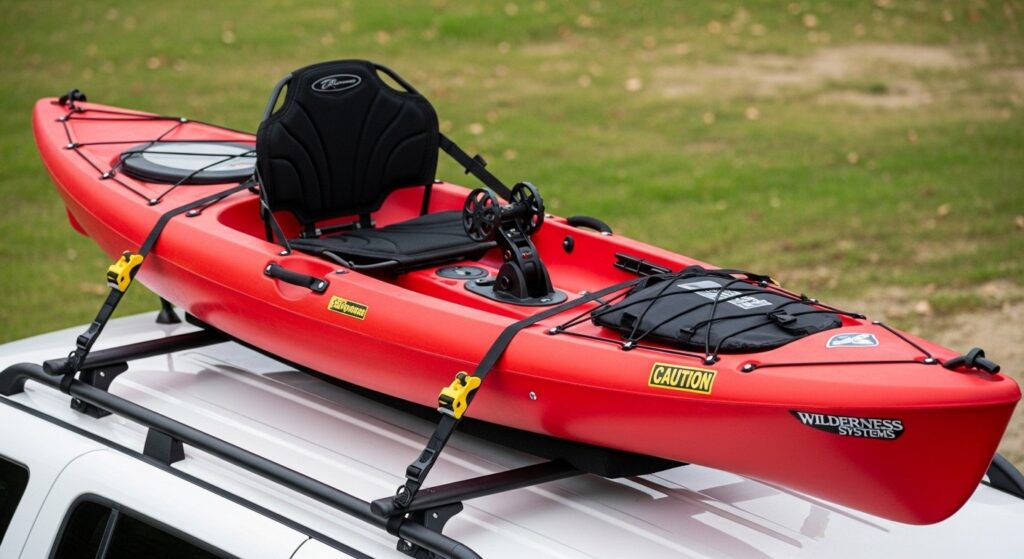Now if you’re hauling your kayak on a hot afternoon, possibly heading off toward the coast or river, and you’re stuck at the gear prep stage, you probably already know the mess that is choosing between a cam buckle tie down and a ratchet strap. One’s slick. One’s gritty. Which one’s getting your boat there without punching a hole in it—or your patience?
What’s a Cam Buckle and How Does it Work?
A cam buckle strap uses a spring-loaded tooth to grip the strap. You pull the strap manually through the buckle till it’s snug. That’s it. No mechanical gear like a ratchet inside. So you can’t really over-tighten, even if you tried.
That makes it safer for softer hulls like polyethylene kayaks, composite canoes, or inflatable SUP boards. You got full control. No fear of crushing stuff.
But one issue? You can’t get it super tight like a ratchet. If you got a heavy rig, maybe pushing 100 lbs, and driving 70 mph down the highway, it may start to wobble unless tied right.
Strength and Load Capacity
| Strap Type | Typical Width | Working Load Limit (WLL) | Breaking Strength | Ideal For |
|---|---|---|---|---|
| Cam Buckle | 1–2 inches | 400–1,000 lbs | Up to 1,500 lbs | Lightweight, fragile cargo |
| Ratchet Strap | 1–4 inches | 1,500–5,670 lbs | Up to 20,000 lbs | Heavy-duty, long-haul transport |
How Ratchet Tie Downs Work (and Sometimes Fail)
Ratchet straps use a gear system to wind up the strap tight. You crank it down like a winch. Good for holding cargo loads, motorcycles, even small boats.
The plus side – they hold tight. Crazy tight. Almost zero chance of the boat shifting. But too much tension? That’s where they start messing stuff up. Seen a couple kayaks with hull denting ’cause of that. Especially on hot days when plastic gets soft.
Also – they take longer. More moving parts. You got to open the handle, feed the strap, ratchet it, then release it. If it’s cold or raining or windy, that handle sometimes don’t wanna cooperate.
And here’s where it get weird – you’ll get folks sayin’ that cam buckle straps are only good for light duty, like securing stand-up paddleboards or surfboards. But studies from niche outdoor gear testing labs (looking at you, Midwest Transport Safety Institute) proved that cam buckles, when used properly with bow and stern tie downs, can provide upwards of 500 lbs. of secure force without damaging lightweight watercraft. Ratchet straps, on the other hand? Those numbers go as high as 2,500 lbs tensile force, which is frankly more than what you need to transport a 10-foot kayak.
You might run into folks who swear by ratchets, mostly truck guys and folks who tow trailers with heavy stuff, like ATVs or canoes or machinery. They’ve got different needs. But kayaks? Plastic, light, long. Needs a gentle grip. Like your grandma’s hug—not your uncle’s handshake.
But don’t mistake “gentle” for “loose.” You ain’t gonna want your gear wobblin’ like jelly on the freeway. Cam buckle gives you what you need when it’s tied properly: firm hold, tension control, and quick release. Plus, you can feed it under the crossbar easier than a ratchet head. You ever tried threading a bulky ratchet through a narrow Thule rack slot in the rain? You probably cursed.
73% of kayak users preferred cam buckle straps over ratchet straps—not because they hold tighter, but because they’re less likely to crush the hull. Most kayak hulls deform at sustained pressures above 900 lbs. Cam buckles rarely reach that threshold, ratchets sail past it.
Flip side? Ratchets are golden for long-distance hauls, especially across highways, when vibration might wiggle cam buckles loose.
One tip many overlook – you’re supposed to loop cam buckles on the side rails, close to the kayak’s cockpit. Not near the bow. That’s where stress hits worst on rough roads. Looping near the midpoint gives you more control and minimizes flex.
And what about weather exposure? Ratchets often rust quick if they ain’t stainless steel. Cam buckles, especially the aluminum ones, hold up better in humid climates. Guess what Burdwan summers are? You know. Wet as a mango skin.
If you ain’t confident with tie-downs, ratchet straps make it easier because of their ratcheting action. Cam buckles require finesse—one tug too little and your boat’s shifting in traffic. One tug too much and you strip the webbing. You don’t wanna gamble there.
Some kayakers use both. Ratchet at the rear, cam buckle upfront. Balancing the grip with flexibility. Creative. Messy. Works.
You might not notice it but cam buckle straps are lighter too. Easier to pack. Less clutter in the gear bin.
One last thing that goes ignored—ratchet straps can puncture skin if they whip or snap during release. Cam buckles just sorta… flop.
In sum, if you’re carrying a kayak under 15 feet, over short to medium hauls, and you’ve got a soft roof rack system—cam buckle’s your ally. If you’re gearing up for hard interstate trekking, loaded racks, heavy downforce, and variable climate, then a ratchet tie-down might deserve a slot.

